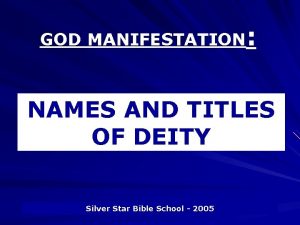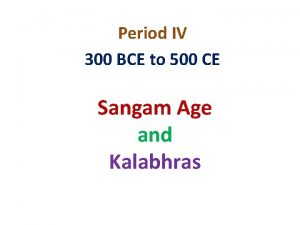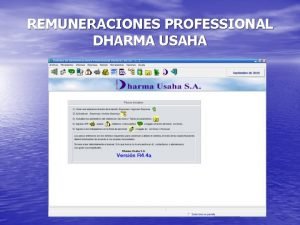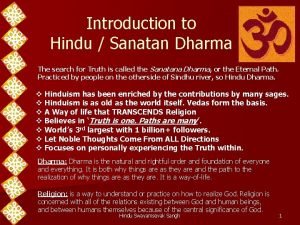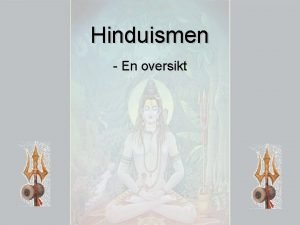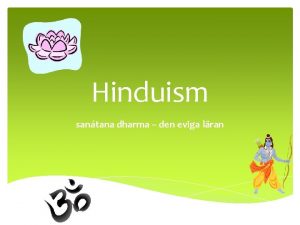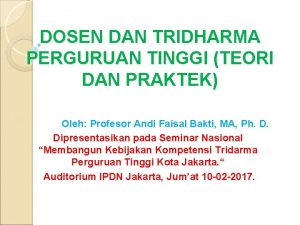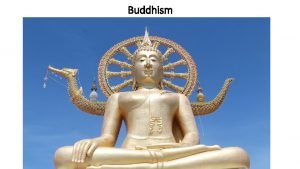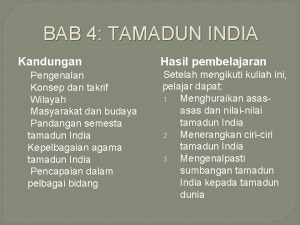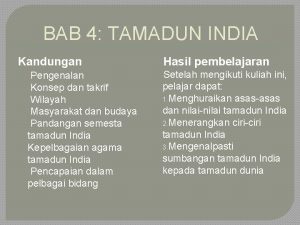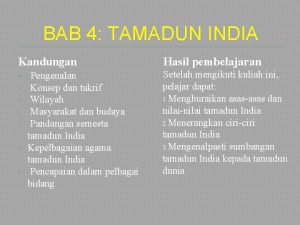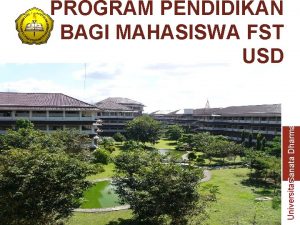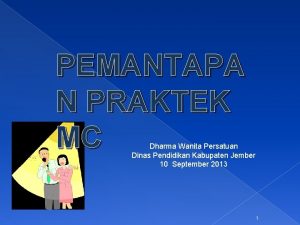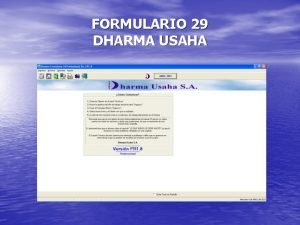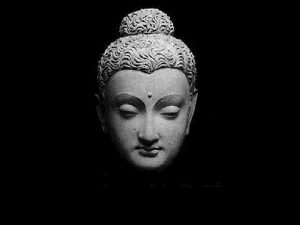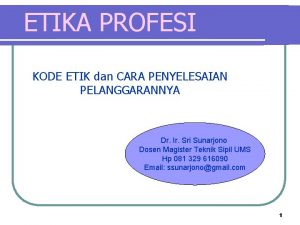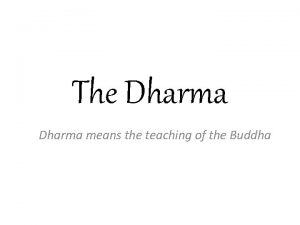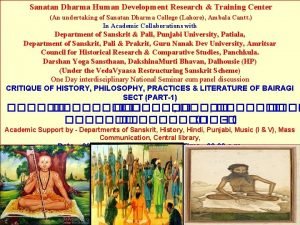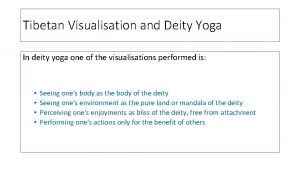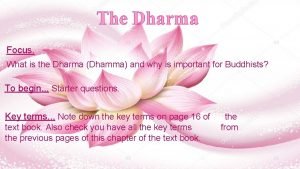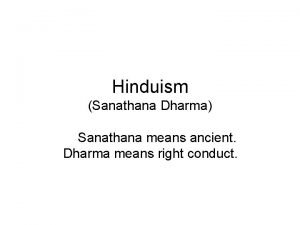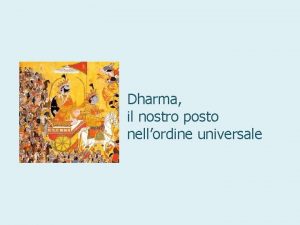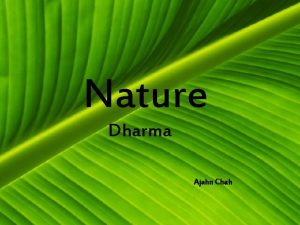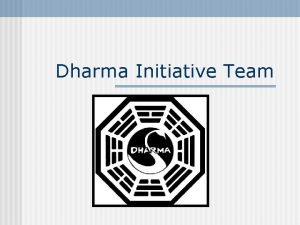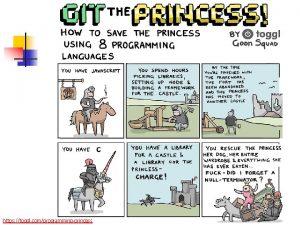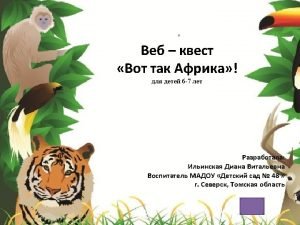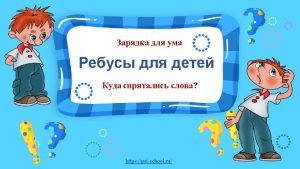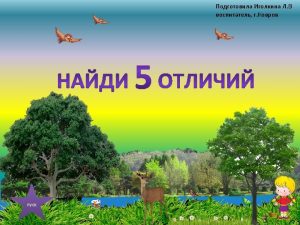Dharma and Deity Upper KS 2 https www




























- Slides: 28

Dharma and Deity Upper KS 2

https: //www. youtube. com/watch? v=Vn 9 BUf UCL 4 I

Think-Pair-Share 1. Were the blind men wrong? 2. Were they right? 3. What do we need to take from the poem? What is the message? 4. Do you think the message is true? 5. Would it be good if everyone remembered this message in their own lives?


https: //www. youtube. com/watch? v=Vgl. GNNr 1 bok

Ahimsa • This is one of the most important Hindu beliefs • It basically means we must do our best not to hurt or harm anyone or anything, but treat them with respect. • The reason is that “God (or spirit) shines in the yes of every living thing, including our own, so when we hurt anyone we are actually hurting ourselves. It is foolish to needlessly hurt other living things. ” • Instead of hurting living things, we should show respect because it is the same God (or spirit) that live sin all of us.

https: //www. youtube. com/watch? v=87 hsm. A Nr. Nn 8

An Acrostic Poem for Ahimsa • An acrostic poem is a type of poetry where the first, last or other letters in a line spell out a particular word or phrase. • Use the acrostic poem template for AHIMSA to write a poem about the meaning of the teaching.

Example of Acrostic Poem

Holi A Hindu Festival of colours

What is Holi? • Holi is a Hindu festival held in the spring celebrated mostly in India. • It’s a time when people remember when good triumphed over evil.

The story of Holi A long time ago, In India, there was a king called Hiranyakashup who had a son called Prahlad. The king wanted everyone to think of him as God and to worship him. As Prahlad grew up he realised that this was not true and refused to worship his father. He worshipped Vishnu, a real God.

Hiranyakashup was very angry and punished his son. However Prahlad still refused to worship him and so the king decided that his son must die. The king tried many different ways to kill Prahlad.

He was put in a pit full of snakes, he was beaten by soldiers and he was trampled by elephants, but each time he prayed to Vishnu and he was saved.

The king’s sister, Holika, agreed to help the king. She was thought to have magical powers which made her fireproof. Holika took Prahlad to the top of a bonfire and the bonfire was lit. Holika expected Prahlad to die. Instead, it was Holika who died and again Prahlad was saved.

Prahlad felt sorry for Holika and promised to name the festival after her. Every year, at the time of Holi, Hindus light bonfires to remind them of this time when good triumphed over evil.

Meaning of the story • The story can teach us something about Ahimsa. Here is what a Hindu told a group of pupils about the story: • “It reminds Hindus that we should use whatever gifts we have to help others not to hurt others. ” • Which part of the story illustrates this best?

How do Hindus celebrate Holi? • Last year’s rubbish is burned so that people can make new beginnings.

• Festival processions and dancing take place.

Hindus also celebrate another story about a boy called Krishna. He used to play tricks on maids like throwing paint at them.

• People throw coloured water or paint at passers by. • People are allowed to be rude to those they normally respect. For instance, pupils may throw things at teachers!!!

https: //www. youtube. com/watch? v=Dnc 2 NQ 8 u. PRQ

Hinduism Assessment Upper KS 2

https: //www. youtube. com/watch? v=Hfhka. Ov. LSA

Assessment • Write 5 questions for the class which you think covers the 5 most important things we have studied about Hinduism • Don’t forget the answers! • Shall we ask the rest of the class?

Making Connections • 12 words associated with Hinduism • Need to pair up the idea with a linking concept. • Connecting ideas must make sense- I am judge. • Only use words once • 1 point per connection • 2 points for connection no one else made. copyright: midwinter 2018

Brahman Vedas Namaste Atman Ahimsa Holi Moksha Reincarnation Dharma Sanatan Dharma Samsara Karma copyright: midwinter 2015

Plenary • Read out connections. • If you/your group has the same two words connected words AND connected ideas raise hand. • Questions to think about: 1. Any words that cannot be connected? Why? 2. Is it easier to work with others? 3. What did you like/not like about the game? 4. Would playing the game a lot make you better at it? 5. What did you learn? copyright: midwinter 2018
 The fool deity
The fool deity Manifestation names
Manifestation names Sri lanka tamil
Sri lanka tamil Trois refuges bouddhisme
Trois refuges bouddhisme Shri narayan dharma paripalana yogam
Shri narayan dharma paripalana yogam Scroblo
Scroblo Pt. dharma kreasi nusantara
Pt. dharma kreasi nusantara Parinibbāna
Parinibbāna Introduction to sanatana dharma
Introduction to sanatana dharma Hva betyr: «santana dharma»?
Hva betyr: «santana dharma»? Helig veckodag hinduism
Helig veckodag hinduism Vad är sanatana dharma hinduism
Vad är sanatana dharma hinduism Tri dharma perguruan tinggi adalah
Tri dharma perguruan tinggi adalah Dharma hjul
Dharma hjul Buddhism symbol hjulet
Buddhism symbol hjulet Wheel symbol meaning
Wheel symbol meaning Konsep tamadun india
Konsep tamadun india Konsep ashrama dharma
Konsep ashrama dharma Ashrama dharma maksud
Ashrama dharma maksud Daftar ulang sanata dharma
Daftar ulang sanata dharma Susunan acara dharma wanita
Susunan acara dharma wanita Dharmausaha
Dharmausaha Dharma marketing
Dharma marketing Kasus pelanggaran kode etik arsitek
Kasus pelanggaran kode etik arsitek Varna dharma
Varna dharma Ubc geology
Ubc geology Dharma
Dharma Sanata dharma meaning
Sanata dharma meaning Dharma
Dharma

